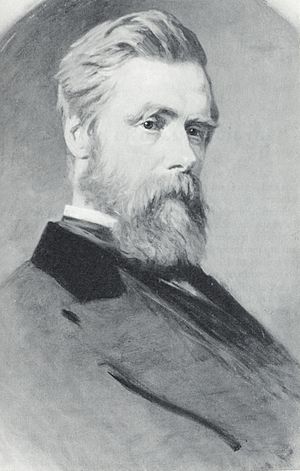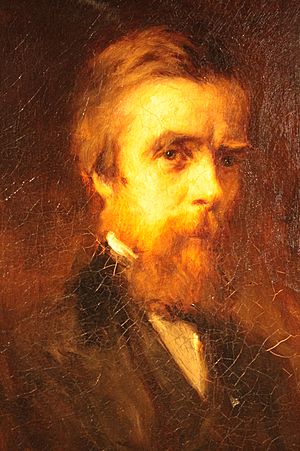William Alexander (journalist and author) facts for kids
Quick facts for kids
William Alexander
|
|
|---|---|
 |
|
| Born | 12 June 1826 Chapel of Garioch, Aberdeenshire, Scotland
|
| Died | 19 February 1894 (aged 67) Aberdeen, Scotland
|
| Nationality | Scottish |
| Occupation | Journalist and Author |
| Movement | Radical Liberal, Land Reform |
William Alexander (born June 12, 1826 – died February 19, 1894) was a Scottish journalist and writer. He is best known for his novel Johnny Gibb of Gushetneuk. This book shows what life was like for people in a farming area of Aberdeenshire in the 1840s. It also talks about a big event called the Disruption, which was a split in the Scottish Church.
Early Life and Learning
William Alexander was born in Chapel of Garioch, a village in Aberdeenshire, Scotland. His family lived near a hill called Bennachie. His father, James Alexander, was a blacksmith and farmer. William grew up on a farm and went to school in Daviot.
He planned to be a farmer, but a serious accident in his early twenties changed his path. He lost a leg, which meant he could no longer work on the farm. While he was getting better, he spent a lot of time reading. He taught himself Latin and learned shorthand, which is a fast way of writing. Soon, he started writing poems and stories for local newspapers and magazines.
A Career in Journalism
William Alexander became a successful writer with help from a group called the Mutual Instruction movement. This group helped people in North-East Scotland learn and grow. William McCombie, a farmer and newspaper editor, was a leader in this movement. He hired William Alexander to work for the Aberdeen Free Press newspaper in 1852.
William Alexander started as a reporter and chief clerk. Later, he became the editor of the newspaper, taking over from McCombie. He became one of the most important journalists in Scotland during the Victorian era. He believed in fairness and change. He supported land reform, which meant making land ownership fairer. He also wanted to get rid of special rights for people born into noble families. He even supported Irish Home Rule, which meant Ireland governing itself. His writing often spoke up for the small farmers in Aberdeenshire.
One of his first big writing projects was a series called Sketches of Rural Life in Aberdeenshire. It started in a newspaper in 1852 and continued for about a year.
In 1865, a cattle disease called rinderpest spread to Aberdeenshire. William Alexander reported on it very carefully. His detailed reports helped local people create ways to stop the disease from spreading further.
In 1886, he wrote another important series of essays called The Aberdeenshire Crofter. These essays supported a campaign to help crofters, who were small tenant farmers. He wanted the Crofters' Holdings Bill, a law designed to protect these farmers, to also apply to Aberdeenshire.
William Alexander was recognized for his important work in journalism. He was made Vice-President of the Institute of Journalists.
His Novels and Stories
William Alexander wrote many novels and stories. He wrote in different styles, from very realistic stories to funny social comedies. His works were often published in parts, or "serially," in popular newspapers. He liked to publish his stories this way instead of as full books right away.
He was very careful to write his characters' speech in a way that showed how people in Aberdeenshire actually spoke the Scots language in the mid-1800s. This made his stories feel very real.
Some of his early works include:
- Sketches of Rural Life in Aberdeenshire (1853)
- The Authentic History of Peter Grundie (1855)
- The Laird of Drammochdyle (1865)
- Ravenshowe and the Residenters Therein (1867)
- Johnny Gibb of Gushetneuk (1869)
The Laird of Drammochdyle looked at how power was changing in society. It showed how old, powerful families were being replaced by new, wealthy business people. This story also showed William Alexander's support for the temperance movement, which aimed to reduce alcohol use.
His most famous novel, Johnny Gibb of Gushetneuk, first appeared in the Aberdeen Free Press from 1869 to 1870. It was then published as a book in 1871. Many people believe this novel is about how owning land affects power and how that power can be misused. It is seen as a story about rural Scotland that is deeply connected to the social and political struggles of the time.
Later, he wrote short stories in a series called Life Among my Ain Folk (1875). These stories, like Mary Malcolmson's Wee Maggie and Couper Sandy, showed the difficult lives of poor farm workers and small tenant farmers as society changed.
His last full novel, My Uncle the Baillie (1876), was published in parts in another Aberdeen newspaper. This book was about local politics in a city that sounded a lot like Aberdeen. It looked at the idea of "Civic Virtue" during the Victorian era with a critical eye.
Personal Life
William Alexander took on the responsibility of supporting his younger brothers and sisters after his father passed away. In 1867, when he was 41, he married Anne Allan, who was a schoolteacher. They did not have any children.
The University of Aberdeen gave William Alexander an honorary degree called Doctor of Law (LLD) to recognize his achievements. There is a special plaque on his house at 3 Belvidere Street in Aberdeen to remember him.
He lived his final years at this house. William Alexander passed away on February 19, 1894, and was buried in Nellfield Cemetery in Aberdeen. His grave is located near the east wall of the cemetery.



